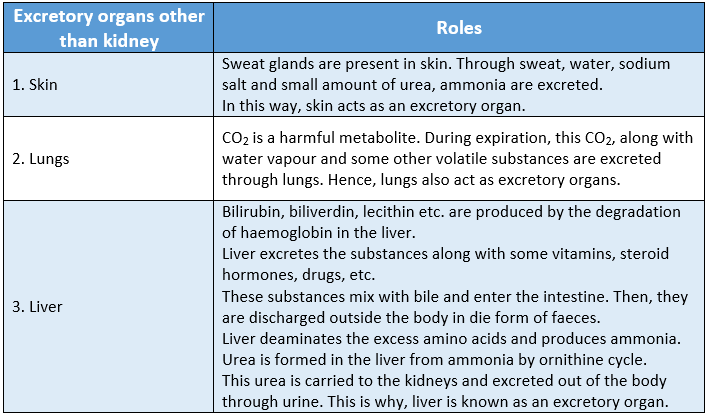Chapter 3 Physiological Processes Of Life Excretion Long Answer Type Questions
Question 1. What is the significance of excretion?
Answer:
Significance of excretion:
Excretion is an important physiological process that helps to lead a healthy life. Its significance is discussed in the next section.
1. Maintenance of a fit and healthy life: Excretion removes all toxic and harmful matters produced in the cells by various metabolic activities.
2. Maintenance of water balance: Excretion removes excess water from the cells to maintain water balance in the body.
3. Recycling of matters: By excretion, many elements, present in the waste materials, are disposed of in nature. These are made available for reuse by the action of decomposers.
4. Economic importance: Many plant excretory products, especially alkaloids, have certain medicinal importance. Gums, resins, tannins, latex, etc. are used for industrial purposes. Some nitrogen-rich animal excretory products are used as fertilizers.

Read and Learn More Class 9 Life Science Long Answer Questions
Question 2 How do plants dispose of excretory materials?
Answer:
Excretion in plants:
Plants eliminate excretory products by the following processes:
1. Shedding of leaves: Trees, such as hog palm, Albizia, silk cotton, etc. store excretory substances in leaves. These trees shed leaves once a year to dispose of those excretory substances.
2 Exfoliation of barks: Some trees, such as guava, Arjun, etc. deposit waste matter in their bark. These plants naturally peel off their bark to eliminate those waste matters from time to time.
3 Shedding of fruits: Plants like lemon, apple, tamarind, etc. store excretory matters, like different organic acids (e.g. citric acid, tartaric acid, malic acid, etc.) or essential oils in their fruits. These are removed from these plants by shedding fruits.
4 Shedding of flowers: In some plants, excretory products are stored in their flowers. These products are excreted when different parts of the flowers are shredded.
Example: Clove flower.
5 Alkaloids: Sometimes alkaloids are stored in the stems and leaves of some plants like banyan, Calotropis, etc. In alkaloids, different types of excretory products remain solubilized. In case of injury, these alkaloids are released outside and in this way, other soluble excretory products are also released.
6 Resin secretion: In the resin ducts of the stem and leaves of some plants, like pine, a complex insoluble excretory product called resin is present.
7 Gum excretion: In some plants such as babul, soluble wastes are excreted in the form of gum.
8 Excretion of water: Potato, tomatoes, etc. solubilize different excretory products in water and then excrete them with the help of hydathodes.

WBBSE Class 9 Excretion Long Answer Questions
Question 3. Compare the different non-nitrogenous excretory products of plants.
Answer:
Non-nitrogenous excretory products of plants:
The non-nitrogenous excretory products of plants are gum, latex, and resin. Comparison among gum, latex, and resin.
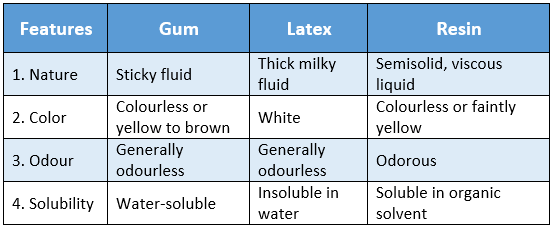
Important Long Answer Questions for Chapter 3 Life Science
Question 4. Distinguish between excretion in plants and animals.
Answer:
Differences between excretion in plants and animals:
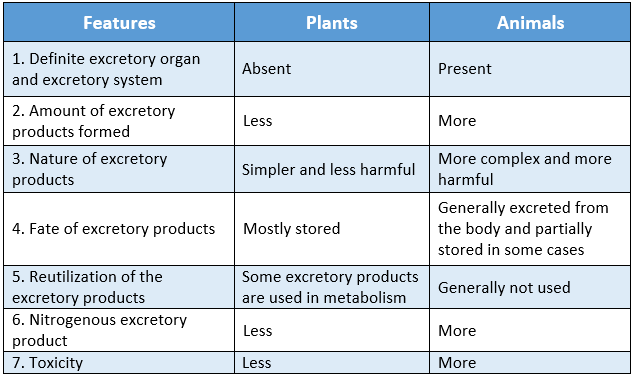
Question 5. Briefly describe the structure of the human excretory system.
Answer:
Structure of the human excretory system:
The human excretory system consists of a pair of kidneys, two ureters, a urinary bladder, and a urethra.
Kidneys:
The kidneys are brown-colored, bean-shaped structures, positioned at either side of the vertebral column, just below the ribs. The concave face of the kidney is called the pelvis.
The section of the kidney shows two distinct regions outer cortex and an inner medulla. A renal artery enters and a renal vein leaves each kidney through the pelvis.
Numerous fine tubular structures, called nephrons, are present in kidneys, which filter blood from the specially designed renal capillaries.
2 Ureter:
Ureters are two in number. Each ureter is a 35 cm long, slightly curved tube, emerging from the renal pelvis. Ureters are usually 2-4 mm in diameter.
The ureters connect kidneys to the urinary bladder, present at the lower portion of the abdominal cavity.
3 Urinary bladder and urethra:
The urinary bladder is a muscular sac, located at the front lower portion of the abdominal cavity. Urethra is a muscular tube that descends from the floor of the bladder.
The base of the urethra is equipped with sphincter muscles, which help to hold the urine inside the urinary bladder. Urine enters the urinary bladder via the ureters and leaves via the urethra. The capacity of a typical human bladder is 300-500 ml.
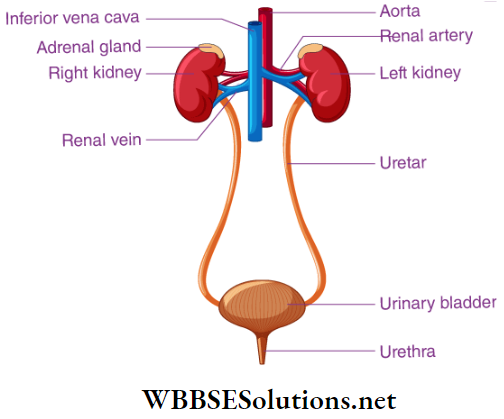
Question 6. Briefly describe the structure of the nephron with a diagram.
Answer:
Structure of nephron:
A nephron has two parts-Malpighian corpuscles and renal tubule.
1 Malpighian corpuscles:
It is situated at the free and blind end of a nephron. This portion is composed of Bowman’s capsule and glomerulus. The free and blind end of the nephron forms a cup-shaped double-walled structure, called the Bowman’s capsule.
A fine branch of the renal artery enters into the Bowman’s capsule as an afferent arteriole. It ramifies to form a capillary network inside the capsule, where these capillaries reunite and return as efferent arteriole. It is comparatively narrower than the afferent arteriole. This capillary network is called the glomerulus.
2 Renal tubule:
It is a convoluted tubule, extending from the base of the Bowman’s capsule and ending in the collecting tubule. The renal tubule has three parts- the proximal convoluted tubule, which starts from the base of the Bowman’s capsule; the loop of Henle, which is a ‘U’-shaped loop-like structure, and the distal convoluted tubule, which ultimately meets a comparatively wider collecting tubule. Several collecting ducts finally unite to form thicker ducts, called the duct of Bellini.
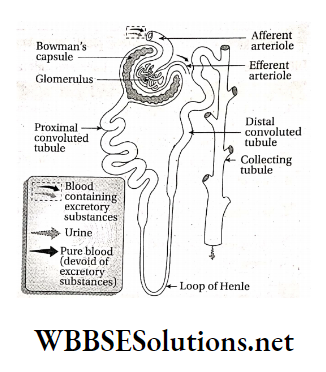
Sample Long Answer Questions from WBBSE Class 9 Life Science
Question 7. Describe the steps of urine formation in the human kidney.
Answer:
Steps of urine formation in the human kidney:
The mechanism of urine formation in the nephron involves four different phases, which are mentioned below.
1 Glomerular ultrafiltration:
Due to increased blood pressure in the glomerular capillaries, water from blood plasma enters Bowman’s capsule. This water carries different excretory materials like urea, uric acid, etc., and many essential substances like glucose, amino acids, smaller protein molecules, salts, ions, vitamins, etc.
This process is known as glomerular ultrafiltration and the dilute fluid, collected in the Bowman’s capsule, is called glomerular filtrate.
2 Reabsorption:
Glucose and different ions (K+, Na+, etc.) are reabsorbed in cells of the renal tubule from the glomerular filtrate by active transport. Cells of proximal convoluted tubules reabsorb the small protein molecules by phagocytosis.
Ions like phosphates, bicarbonates, chlorine, etc., vitamin C, amino acids, and many other substances are reabsorbed by the renal tubule. All these reabsorbed essential materials then return to the blood.
3 Secretion: Creatine, creatinine, hippuric acid, etc. are some excretory materials, which are secreted from the renal tubule.
4 Passive absorption of water:
Excess water from the glomerular filtrate is reabsorbed by passive transport in the loop of Henle and the distal convoluted tubule. Reabsorption of water is controlled by a posterior pituitary hormone, named Antidiuretic Hormone (ADH).
After these four steps, normally concentrated urine is formed in the nephron, which is received by the collecting tubule and finally reaches the duct of Bellini.
Concepts Related to Physiological Processes for Long Answers
Question 8. Write about the roles of the accessory excretory organs other than the kidney.
Answer:
Roles of excretory organs other than kidney:
